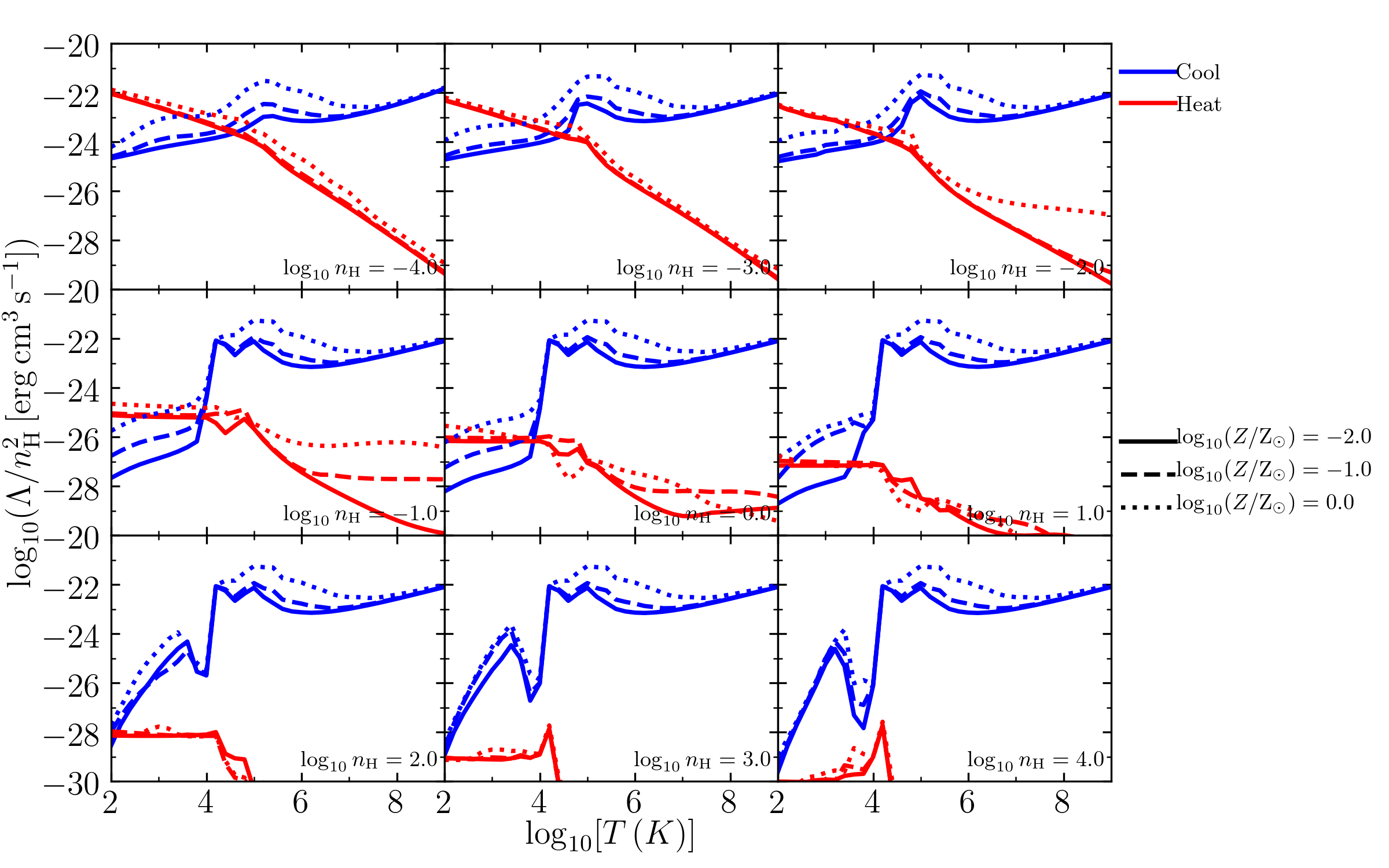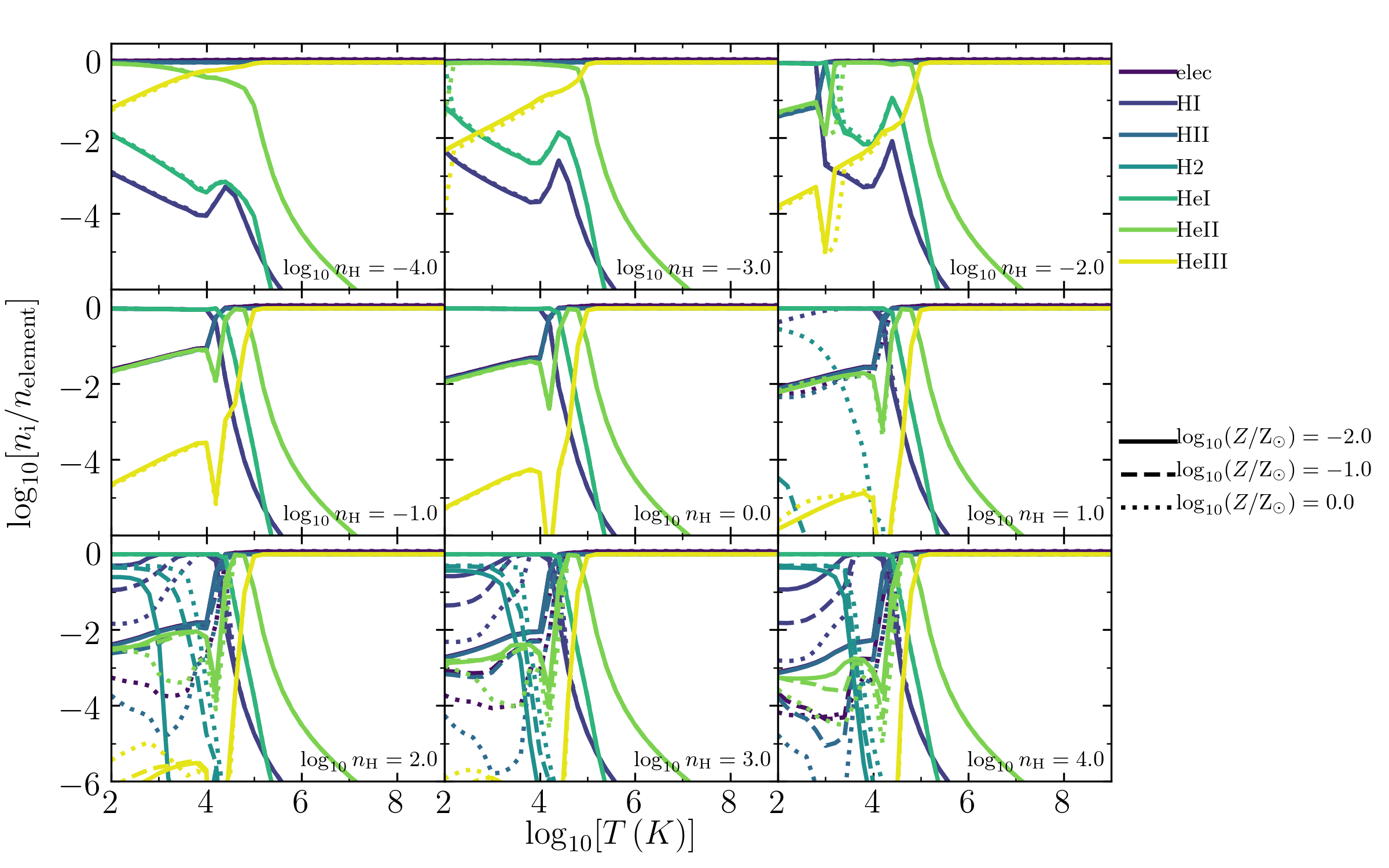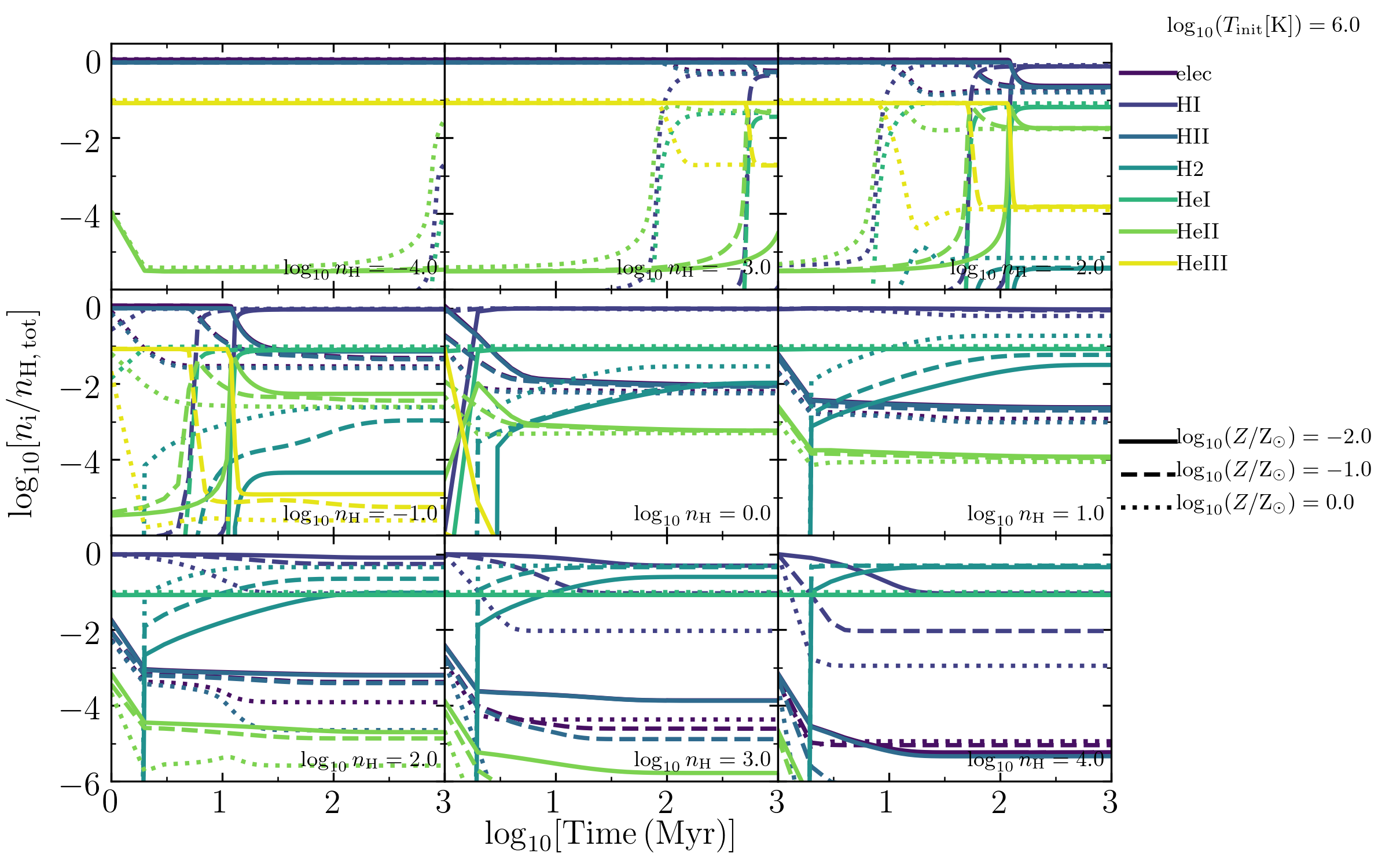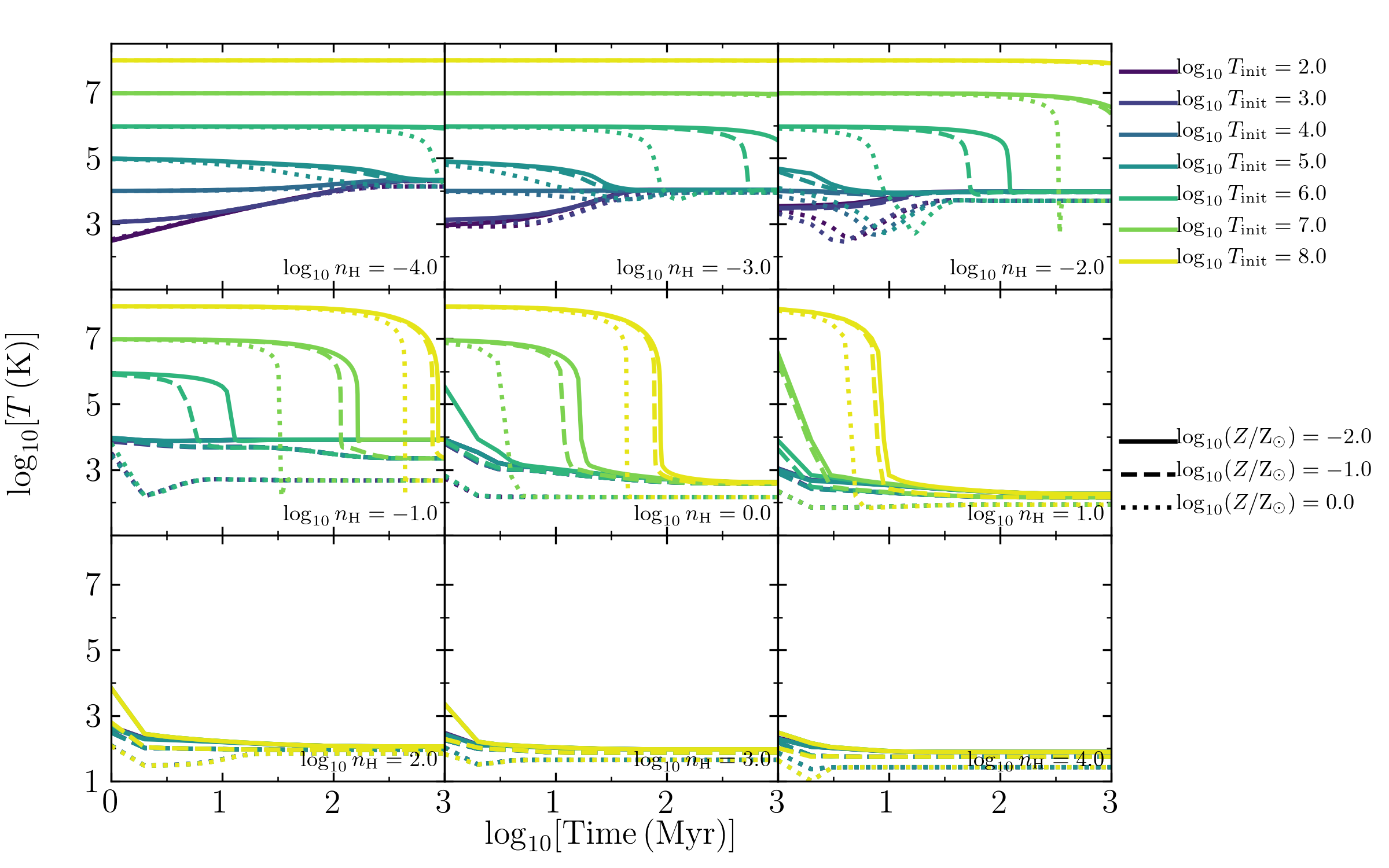Examples
The examples/ directory in the chimes-driver repository contains several example parameter files for Chimes Driver. We describe the parameters used in each example below.
cooling_rates
Creates a table of cooling and heating rates on a grid of temperature, density and metallicity.
chimes_library_path /home/username/chimes/libchimes.so
chimes_data_path /home/username/chimes-data
Defines the paths to the CHIMES library and CHIMES data repository.
driver_mode cooling_rates
IO_mode grid
Defines the mode in which Chimes Driver will be run, i.e. to compute cooling and heating rates from the final chemical state on a grid of temperature, density and metallicity.
output_file ./cooling_rates.hdf5
The name of the file that the outputs will be written out to.
UV_field B87
shield_mode Jeans
dust_depletion None
Sets the UV radiation field, shielding length and dust depletion model. In this example, we use the local interstellar radiation field from Black (1987), a shielding length equal to the Jeans length, and a fixed dust-to-metals ratio without accounting for the reduction of metal abundances from the gas phase due to depletion on to dust grains.
log_T_min 2.0
log_T_max 9.0
delta_log_T 0.2
log_nH_min -4.0
log_nH_max 4.0
delta_log_nH 1.0
log_Z_min -2.0
log_Z_max 0.0
delta_log_Z 0.5
Defines the extent and logarithmic spacing of the grid in temperature, density and metallicity.
shield_length_factor 1.0
max_shield_length 3.086e23
Defines a multiplicative factor to multiply all shielding lengths by (in this case unity, i.e. we will just be using the Jeans length), and a maximum shielding length of 100 kpc.
n_iterations 10
Defines how many iterations to integrate the chemistry for on each point in the grid. The column densities of individual species are updated between each iteration.
StaticMolCooling 1
The CO and H2O cooling rates are calculated for a static gas distribution, i.e. based only on thermal line broadening.
Tmol_K 1.0e5
Maximum temperature for the molecular network. Above this temperature, molecule abundances are set to zero and molecular reactions are excluded from the network.
InitIonState 1
The chemistry integration will be started from a singly ionised initial state.
grain_temperature 10.0
The temperature of dust grains is set to 10 K.
cmb_temperature 2.725
The temperature of the Cosmic Microwave Background is set to 2.725 K.
relativeTolerance 1.0e-4
absoluteTolerance 1.0e-10
explicitTolerance 1.0e-5
scale_metal_tolerances 1
Defines the various tolerance parameters used to control the accuracy of the chemistry integration.
IncludeCarbon 1
IncludeNitrogen 1
IncludeOxygen 1
IncludeNeon 1
IncludeMagnesium 1
IncludeSilicon 1
IncludeSulphur 1
IncludeCalcium 1
IncludeIron 1
Defines which metal elements to include in the non-equilibrium network. In this example, all metals are included.
cr_rate 1.8e-16
The ionisation rate of HI due to cosmic rays, in units of s^-1.
doppler_broad 7.1
Doppler broadening parameter for the H2 self-shielding function, in units of km/s.
ForceEqOn 0
Setting this to zero tells CHIMES to integrate the chemistry in non-equilibrium.
ThermEvolOn 0
Setting this to zero disables the temperature evolution, i.e. the temperature is held fixed as the chemical abundances are evolved.
hydro_timestep 3.16e16
The total time to integrate the chemistry over for each iteration, in seconds. This value correspond to 1 Gyr.
Results
Cooling (blue) and heating (red) rates versus temperature for different densities and metallicities:

eqm_table
Creates a table of equilibrium abundances on a grid of temperature, density and metallicity. The output HDF5 file is in a format that can be used as the equilibrium abundance table for other runs with CHIMES, which will then set the abundances to equilibrium by interpolating this table if the ForceEqOn parameter is set to 1.
chimes_library_path /home/username/chimes/libchimes.so
chimes_data_path /home/username/chimes-data
Defines the paths to the CHIMES library and CHIMES data repository.
driver_mode eqm_table
IO_mode grid
Defines the mode in which Chimes Driver will be run, i.e. to create an equilibrium abundance table on a grid of temperature, density and metallicity.
output_file ./eqm_table.hdf5
The name of the file that the outputs will be written out to.
UV_field Colibre
shield_mode Colibre
dust_depletion Colibre
Sets the UV radiation field, shielding length and dust depletion model. In this example, we use the Colibre model for all three (see Ploeckinger & Schaye 2020 for details).
log_T_min 2.0
log_T_max 9.0
delta_log_T 0.2
log_nH_min -4.0
log_nH_max 4.0
delta_log_nH 1.0
log_Z_min -2.0
log_Z_max 0.0
delta_log_Z 0.5
Defines the extent and logarithmic spacing of the grid in temperature, density and metallicity.
shield_length_factor 0.5
max_shield_length 3.086e23
Defines a multiplicative factor to multiply all shielding lengths by (in this case 0.5) and a maximum shielding length of 100 kpc, as used in Ploeckinger & Schaye (2020).
colibre_log_T_min 4.0
colibre_log_T_max 5.0
colibre_scale_MW_ISRF 1.0
colibre_ISRF_low_dens_cut_off_redshift 7.5
colibre_use_turbulent_jeans_length 1
colibre_sigma_turb 6.0
colibre_saturate_radiation_field 0
colibre_saturate_cr_rate 0
colibre_cr_plaw_index 1.0
dust_boost_mode 2
dust_boost_factor 300.0
dust_boost_nH_min_cgs 1.0
dust_boost_nH_max_cgs 100.0
Parameters used in the Colibre model for the radiation field, shielding length and dust depletion. Some of these are described in Ploeckinger & Schaye (2020), however some of these include updates to the Colibre model implemented after Ploeckinger & Schaye (2020). The values given here are for the default model used in Colibre.
n_iterations 10
Defines how many iterations to integrate the chemistry for on each point in the grid. The column densities of individual species are updated between each iteration.
StaticMolCooling 1
The CO and H2O cooling rates are calculated for a static gas distribution, i.e. based only on thermal line broadening.
Tmol_K 1.0e5
Maximum temperature for the molecular network. Above this temperature, molecule abundances are set to zero and molecular reactions are excluded from the network.
InitIonState 1
The chemistry integration will be started from a singly ionised initial state.
grain_temperature 10.0
The temperature of dust grains is set to 10 K.
cmb_temperature 2.725
The temperature of the Cosmic Microwave Background is set to 2.725 K.
relativeTolerance 1.0e-4
absoluteTolerance 1.0e-10
explicitTolerance 0.05
scale_metal_tolerances 1
Defines the various tolerance parameters used to control the accuracy of the chemistry integration.
IncludeCarbon 1
IncludeNitrogen 1
IncludeOxygen 1
IncludeNeon 1
IncludeMagnesium 1
IncludeSilicon 1
IncludeSulphur 1
IncludeCalcium 1
IncludeIron 1
Defines which metal elements to include in the non-equilibrium network. In this example, all metals are included.
redshift 0.0
reionisation_redshift 7.5
Defines the redshift and reionisation redshift used for the extragalactic UV background component of the Colibre radiation field model.
cr_rate 1.8e-16
The ionisation rate of HI due to cosmic rays, in units of s^-1. With the Colibre UV_field model, the cr_rate then gets scaled along with the interstellar radiation field component of the radiation field (see Ploeckinger & Schaye 2020).
doppler_broad 8.485
Doppler broadening parameter for the H2 self-shielding function, in units of km/s.
ForceEqOn 0
Setting this to zero tells CHIMES to integrate the chemistry in non-equilibrium.
ThermEvolOn 0
Setting this to zero disables the temperature evolution, i.e. the temperature is held fixed as the chemical abundances are evolved.
hydro_timestep 3.16e16
The total time to integrate the chemistry over for each iteration, in seconds. This value correspond to 1 Gyr.
Results
Abundances of electrons and hydrogen and helium species versus temperature for different densities and metallicities.

GIZMO_snapshot_eqm_state
Computes the equilibrium chemical state for each gas particle in a GIZMO snapshot.
chimes_library_path /home/username/chimes/libchimes.so
chimes_data_path /home/username/chimes-data
Defines the paths to the CHIMES library and CHIMES data repository.
driver_mode eqm_state
IO_mode snapshot
Defines the mode in which Chimes Driver will be run, i.e. to compute the equilibrium chemical abundances for each gas particle in a snapshot.
input_file snapshot_500.hdf5
output_file snap500_eqm.hdf5
The name of the input snapshot file and the output file. In this example, we write the final equilibrium abundances to a separate file.
snapshot_type GIZMO
Defines the type of snapshot. In this example, we use a GIZMO snapshot.
snapshot_chemistry_array None
By setting this to None, Chimes Driver will not try to read in the initial chemistry abundances from the snapshot. Instead, we will simply set the initial chemical state by hand, according to the InitIonState parameter (see below).
snapshot_flux_ion_array ChimesFluxIon_output
snapshot_flux_G0_array ChimesFluxG0_output
Defines the names of the arrays containing the stellar fluxes for each gas particle, in the >13.6 eV and the 6-13.6 eV bands, respectively. Since we will be computing the stellar fluxes from the star particles in this example (see below), the resulting stellar fluxes will be written out to these arrays in the output file.
snapshot_cosmo_flag 0
This tells Chimes Driver that the snapshot is from a non-cosmological simulation, i.e. the units are physical, not co-moving.
snapshot_unitMass_cgs 1.989e43
snapshot_unitLength_cgs 3.0857e21
snapshot_unitVelocity_cgs 1.0e5
Defines conversions between code units and cgs units in the snapshot.
compute_stellar_fluxes 1
By setting this to 1, we will compute the stellar fluxes for each gas particle from the star particles in the snapshot, according to Richings et al. (in prep).
stellar_fluxes_fEsc_ion 0.05
stellar_fluxes_fEsc_G0 0.1
Defines the escape fractions of radiation in each band from the neighbourhood of each star particle.
UV_field StellarFluxes
shield_mode Jeans
dust_depletion DC16
Sets the UV radiation field, shielding length and dust depletion model. In this example, we use the stellar fluxes from star particles (see Richings et al. in prep), a shielding length equal to the Jeans length, and dust depletion factors based on the observations of De Cia et al. (2016).
n_iterations 10
Defines how many iterations to integrate the chemistry for on each point in the grid. The column densities of individual species are updated between each iteration.
StaticMolCooling 1
The CO and H2O cooling rates are calculated for a static gas distribution, i.e. based only on thermal line broadening.
Tmol_K 1.0e5
Maximum temperature for the molecular network. Above this temperature, molecule abundances are set to zero and molecular reactions are excluded from the network.
InitIonState 1
The chemistry integration will be started from a singly ionised initial state.
grain_temperature 10.0
The temperature of dust grains is set to 10 K.
cmb_temperature 2.725
The temperature of the Cosmic Microwave Background is set to 2.725 K.
relativeTolerance 1.0e-4
absoluteTolerance 1.0e-10
explicitTolerance 0.05
scale_metal_tolerances 1
Defines the various tolerance parameters used to control the accuracy of the chemistry integration.
IncludeCarbon 1
IncludeNitrogen 1
IncludeOxygen 1
IncludeNeon 1
IncludeMagnesium 1
IncludeSilicon 1
IncludeSulphur 1
IncludeCalcium 1
IncludeIron 1
Defines which metal elements to include in the non-equilibrium network. In this example, all metals are included.
cr_rate 1.8e-16
The ionisation rate of HI due to cosmic rays, in units of s^-1.
doppler_broad 7.1
Doppler broadening parameter for the H2 self-shielding function, in units of km/s.
ForceEqOn 0
Setting this to zero tells CHIMES to integrate the chemistry in non-equilibrium.
ThermEvolOn 0
Setting this to zero disables the temperature evolution, i.e. the temperature is held fixed as the chemical abundances are evolved.
hydro_timestep 3.16e16
The total time to integrate the chemistry over for each iteration, in seconds. This value correspond to 1 Gyr.
grid_noneq_evolution
Records the non-equilibrium evolution of temperature and chemical abundances on a grid of initial temperature, density and metallicity.
chimes_library_path /home/username/chimes/libchimes.so
chimes_data_path /home/username/chimes-data
Defines the paths to the CHIMES library and CHIMES data repository.
driver_mode noneq_evolution
IO_mode grid
Defines the mode in which Chimes Driver will be run, i.e. to compute the non-equilibrium evolution of temperature and chemical abundances on a grid of initial temperature, density and metallicity.
output_file ./grid_noneq_evolution.hdf5
The name of the file that the outputs will be written out to.
UV_field HM12
shield_mode Jeans
dust_depletion None
Sets the UV radiation field, shielding length and dust depletion model. In this example, we use the extragalactic UV background from Haardt & Madau (2012), a shielding length equal to the Jeans length, and a fixed dust-to-metals ratio without accounting for the reduction of metal abundances from the gas phase due to depletion on to dust grains.
log_T_min 2.0
log_T_max 8.0
delta_log_T 1.0
log_nH_min -4.0
log_nH_max 4.0
delta_log_nH 1.0
log_Z_min -2.0
log_Z_max 0.0
delta_log_Z 1.0
shield_length_factor 1.0
max_shield_length 3.086e23
Defines a multiplicative factor to multiply all shielding lengths by (in this case unity, i.e. we will just be using the Jeans length), and a maximum shielding length of 100 kpc.
n_iterations 1000
Defines how many iterations to integrate the chemistry for on each point in the grid. We record the temperature and chemical state after each iteration.
StaticMolCooling 1
The CO and H2O cooling rates are calculated for a static gas distribution, i.e. based only on thermal line broadening.
Tmol_K 1.0e5
Maximum temperature for the molecular network. Above this temperature, molecule abundances are set to zero and molecular reactions are excluded from the network.
InitIonState 1
The chemistry integration will be started from a singly ionised initial state.
grain_temperature 10.0
The temperature of dust grains is set to 10 K.
cmb_temperature 2.725
The temperature of the Cosmic Microwave Background is set to 2.725 K.
relativeTolerance 1.0e-4
absoluteTolerance 1.0e-10
explicitTolerance 0.05
scale_metal_tolerances 1
Defines the various tolerance parameters used to control the accuracy of the chemistry integration.
IncludeCarbon 1
IncludeNitrogen 1
IncludeOxygen 1
IncludeNeon 1
IncludeMagnesium 1
IncludeSilicon 1
IncludeSulphur 1
IncludeCalcium 1
IncludeIron 1
Defines which metal elements to include in the non-equilibrium network. In this example, all metals are included.
redshift 0.0
reionisation_redshift 7.5
Defines the redshift and reionisation redshift used for the Haardt & Madau (2012) extragalactic UV background.
cr_rate 1.8e-16
The ionisation rate of HI due to cosmic rays, in units of s^-1.
doppler_broad 7.1
Doppler broadening parameter for the H2 self-shielding function, in units of km/s.
ForceEqOn 0
Setting this to zero tells CHIMES to integrate the chemistry in non-equilibrium.
ThermEvolOn 1
Setting this to one enables the temperature evolution.
hydro_timestep 3.16e13
The total time to integrate the chemistry over for each iteration, in seconds. This value correspond to 1 Myr.
Results
Abundances of electrons and hydrogen and helium species versus time for different densities and metallicities, with an initial temperature of 1e6 K.

Temperature versus time for different initial temperatures, densities and metallicities.
